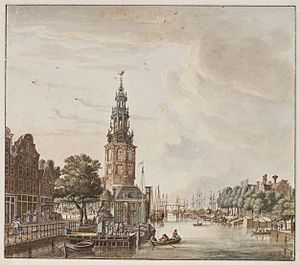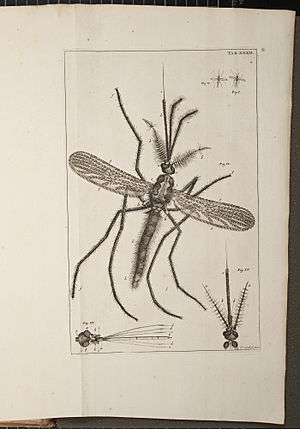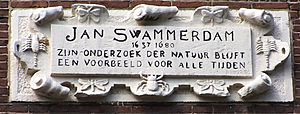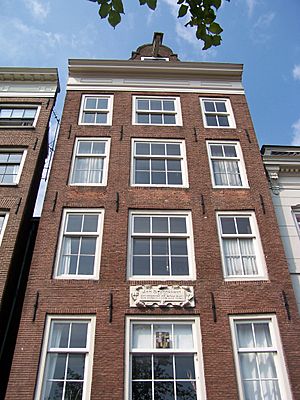Jan Swammerdam facts for kids
Quick facts for kids
Jan Swammerdam
|
|
|---|---|
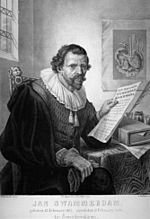
A 19th century fantasy portrait: no genuine portrait of Jan Swammerdam is known.
|
|
| Born | 12 February 1637 |
| Died | 17 February 1680 (aged 43) Amsterdam, Dutch Republic
|
| Nationality | Dutch |
| Alma mater | University of Leiden |
| Known for | Describing erythrocytes, work on entomology |
| Scientific career | |
| Fields | Entomology |
Jan Swammerdam (12 February 1637 – 17 February 1680) was a Dutch biologist and microscopist. His work on insects showed that the stages an insect life – egg, larva, pupa, and adult – are different forms of the same animal. He did experiments on muscle contraction. In 1658, he was the first to observe and describe red blood cells. He was one of the first people to use the microscope in dissections, and his techniques remained useful for hundreds of years.
Education
Johannes Swammerdam was baptized on 15 February 1637 in the Oude Kerk Amsterdam. His father Jan (or Johannes) Jacobsz (-1678) was an apothecary and an amateur collector of minerals, coins, fossils, and insects from around the world. In 1632 he married Baartje Jans (-1660) in Weesp. The couple lived across the Montelbaanstoren, near the harbour, the headquarter and the warehouses of the Dutch West India Company where an uncle worked. Some of their children were buried in the Walloon church, likewise Jan himself (who never married) and his father.
As a youngster, Swammerdam had helped his father to take care of his curiosity collection. Despite his father's wish that he should study theology Swammerdam started to study medicine in 1661 at the University of Leiden. He studied under the guidance of Johannes van Horne and Franciscus Sylvius. Among his fellow students were Frederik Ruysch, Reinier de Graaf, Ole Borch, Theodor Kerckring, Steven Blankaart, Burchard de Volder, Ehrenfried Walther von Tschirnhaus and Niels Stensen. While studying medicine Swammerdam started his own collection of insects.
In 1663 Swammerdam moved to France to continue his studies. It seems together with Steno. He studied for one year at the Protestant University of Saumur, under the guidance of Tanaquil Faber. Subsequently, he studied in Paris at the scientific academy of Melchisédech Thévenot. 1665 he returned to the Dutch Republic and joined a group of physicians who performed dissections and published their findings. Between 1666 and 1667 Swammerdam concluded his study of medicine at the University of Leiden; he received his doctorate in medicine in 1667 under van Horne for his dissertation on the mechanism of respiration, published under the title De respiratione usuque pulmonum.
Research on insects
Knowledge of insects in the 17th century was to a great extent inherited from Aristotle. Swammerdam dissected insects and studied them under microscopes.
Swammerdam showed that insects develop in the same gradual manner as do other animals. He wanted to dispel the seventeenth-century idea that different life stages of an insect (e.g. caterpillar and butterfly) were different individuals.
He got evidence from his dissections. By examining larvae, he identified adult features in pre-adult animals. For example, he noticed that the wings of dragonflies and mayflies exist before their final molt. Swammerdam used these observations in his 1669 publication, Historia Insectorum Generalis (The Natural History of Insects). This work included many descriptions of insect anatomy. Biblia natura (The Bilbe of Nature) published in 1737, carried the first confirmation that the queen bee is the sole mother of the colony. Despite five intense years of beekeeping, the mode of honey bee reproduction escaped him.
Legacy
Together with his father he collected 6,000 objects in 27 drawer cabinets. Swammerdam's Historia insectorum generalis was widely known and applauded before he died. Two years after his death in 1680 it was translated into French and in 1685 it was translated into Latin. John Ray, author of the 1705 Historia insectorum, praised Swammerdam' methods, they were "the best of all". Though Swammerdam's work on insects and anatomy was significant, many current histories remember him as much for his methods and skill with microscopes as for his discoveries. He developed new techniques for examining, preserving, and dissecting specimens, including wax injection to make viewing blood vessels easier. A method he invented for the preparation of hollow human organs was later much employed in anatomy. He had corresponded with contemporaries across Europe and his friends Gottfried Wilhelm Leibniz and Nicolas Malebranche used his microscopic research to substantiate their own natural and moral philosophy. But Swammerdam has also been credited with heralding the natural theology of the 18th century, were God's grand design was detected in the mechanics of the Solar System, the seasons, snowflakes and the anatomy of the human eye. An English translation of his entomological works by T. Floyd was published in 1758.
No authentic portrait of Jan Swammerdam is extant nowadays. The portrait shown in the header is derived from the painting The Anatomy Lesson of Dr Tulp by Rembrandt and represents the leading Amsterdam physician Hartman Hartmanzoon (1591–1659).
Images for kids
-
Swammerdam's illustration of a nerve-muscle preparation. He placed a frog thigh muscle in a glass syringe with a nerve protruding from a hole in the side of the container. Irritating the nerve caused the muscle to contract, but the level of the water, and thus the volume of the muscle, did not increase.
See also
 In Spanish: Jan Swammerdam para niños
In Spanish: Jan Swammerdam para niños


